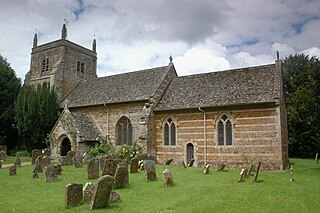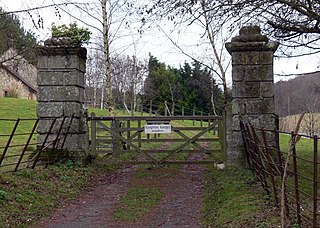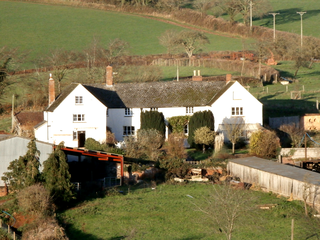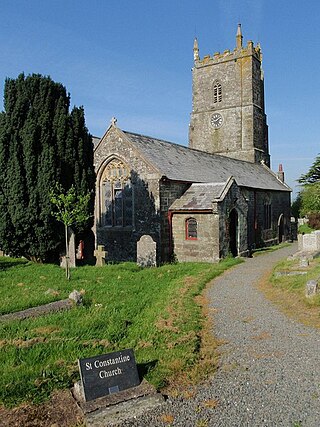Related Research Articles

Beddington is a suburban settlement in the London Borough of Sutton on the boundary with the London Borough of Croydon. Beddington is formed from a village of the same name which until early the 20th century still included land which became termed entirely as Wallington. The latter was in the 13th century shown on local maps as Hakebrug, and named after a bridge on the River Wandle. The locality has a landscaped wooded park at Beddington Park – also known as Carew Manor; and a nature reserve and sewage treatment works in the centre and to the north of its area respectively. The population of Beddington according to the 2011 census is 21,044.

Barton Hartshorn is a civil parish about 4 miles (6.4 km) southwest of Buckingham in Buckinghamshire, within the Buckinghamshire Council unitary authority area. Its southern boundary is a brook called the Birne, and this and the parish's western boundary form part of the county boundary with Oxfordshire. At the 2011 Census the population of the parish was included in the civil parish of Chetwode

New Milton is a market town in southwest Hampshire, England. To the north is in the New Forest and to the south the coast at Barton-on-Sea. The town is equidistant between Lymington and Christchurch, 6 miles (9.7 km) away.

Earl of Mount Edgcumbe is a title in the Peerage of Great Britain. It was created in 1789 for George Edgcumbe, 3rd Baron Edgcumbe. This branch of the Edgcumbe family descends from Sir Piers Edgcumbe of Cotehele in Cornwall, who acquired an estate near Plymouth through marriage in the early 16th century, which was later re-named "Mount Edgcumbe". His descendant Richard Edgcumbe was a prominent politician and served as Paymaster-General of Ireland and as Chancellor of the Duchy of Lancaster. In 1742, he was created Baron Edgcumbe, of Mount Edgcumbe in the County of Devon, in the Peerage of Great Britain. Richard Edgcumbe was succeeded by his eldest son, the second Baron. He represented Plympton Erle, Lostwithiel and Penrhyn in the House of Commons and served as Lord-Lieutenant of Cornwall. On his death, the title passed to his younger brother, the third Baron. He was an Admiral of the Blue and also held political office as Treasurer of the Household and as Captain of the Honourable Band of Gentlemen Pensioners. In 1781, he was created Viscount Mount Edgcumbe and Valletort and in 1789 he was further honoured when he was made Earl of Mount Edgcumbe. Both titles are in the Peerage of Great Britain.

Barton on Sea is a cliff-top village in Hampshire, England close to the town New Milton, which is its civil parish to the north. As a settlement, Barton has a history dating back to Anglo-Saxon times. Barton is notable for the many fossils to be found in the Barton geological beds in the cliffs, as well as for the significant sea defences built to guard the cliffs against coastal erosion. Barton on Sea is a very popular retirement location. Approximately 36% of the population are retired. The population of Barton in the 2001 census was 6,849.

Duns Tew is an English village and civil parish about 7+1⁄2 miles (12 km) south of Banbury in Oxfordshire. The 2011 Census recorded the parish's population as 478. With nearby Great Tew and Little Tew, Duns Tew is one of the three villages known collectively as "The Tews". A 'tew' is believed to be an ancient term for a ridge of land.
Sandford is a village and civil parish in the Mid Devon district, within Devon, England. Sandford is part of the electoral ward named Sandford and Creedy. The ward population at the 2011 Census was 3,429.

The Gorges family was an Anglo-Norman family with lands in the southwest of England. They obtained the manors of Wraxall, Somerset and Bradpole in Dorset.

The Great Budbridge Manor is a manor house just south of Merstone, near Arreton, Isle of Wight, England. Fish ponds on the grounds appear medieval.

Knighton Gorges Manor was one of the grandest manor houses on the Isle of Wight, located in the hamlet of Knighton, near Newchurch.
Ryde Manor is a manor house in Ryde on the Isle of Wight, situated within the Newchurch parish. It was historically linked with Ashey Manor.
Haven Street Manor is a manor house on the Isle of Wight, situated at Havenstreet within the Newchurch parish.
Wroxall Manor was a manor house on the Isle of Wight, situated in the Newchurch parish.
Wackland Manor, is a manor house on the Isle of Wight, situated in the Newchurch parish. It was held in the 13th century under the Lisles of Wootton, but in 1311–12 was said to be held of Ralph de Gorges of Knighton Gorges Manor. At the end of the 13th century it was held by John de la Brigge, from whom it passed with Bridge Court (q.v.) to the Kingstons. It followed the descent of Kingston until 1424, when Robert Dingley and Lewis Meux conveyed it to John Taillour, who was returned in 1431 as holding Wackland. Its descent has not been traced from that time until the end of the 18th century. Some time before 1786 it must have been in the possession of Thomas Davis, as he left a charge of 20s. upon it for charities. In the early part of the 19th century Wackland was the residence of a hunting farmer, well known as 'Squire' Thatcher, who kept and hunted a pack of harriers. Mr. E. Carter was lord of Wackland in 1878, and as of 1912 it belonged to the trustees of the late Mr. Thomas F. Perrott.
The Manor of Bratton Fleming was a medieval manor estate in Bratton Fleming, Devon, England.

Ruxford is an historic estate in the parish of Sandford, near Crediton in Devon.

Milton Abbot is a village, parish, and former manor in Devon, 6 miles (9.7 km) north-west of Tavistock, Devon, and 6 miles (9.7 km) south-east of Launceston, Cornwall.
The manor of Hillersdon was a historic manor in the parish of Cullompton, Devon, England which was held by the de Hillersdon family from the 13th century until the early 16th century. It was then held by a number of different families including the Cockeram, Cruwys and Grant families. Hillersdon House was built in the nineteenth century by the Grant family and is still in use.

Maurice George Bisset (1757–1821) of Knighton Gorges on the Isle of Wight, and of Lessendrum in Aberdeen, Scotland, 18th Scottish feudal baron of Lessendrum, is famous for his involvement in the scandalous court case involving his mistress Seymour Dorothy Fleming and her husband Sir Richard Worsley, 7th Baronet, of Appuldurcombe House, Isle of Wight. The case was the result of his affair with Lady Worseley, by whom he had a daughter, Jane Seymour Worsley, of whom Richard claimed paternity in order to avoid scandal.

Speccot is an historic estate in the parish of Merton in Devon, England. It was the seat of the de Speccot family, one of the oldest gentry families in Devon, which founded almshouses at Taddiport, near Great Torrington, Devon, in the 13th century. It is situated about one mile south-west of Potheridge, the seat of the Monck family from before 1287 to the late 17th century, who were thus close neighbours of the de Speccot family for many centuries. The present farmhouse known as "Speccot Barton" is Victorian and although no obvious traces of an earlier house survive, is marked "On Site of a Mansion" on the First Edition Ordnance Survey 25 inch map of 1880-99. The estate is today operated as a family-run sheep farm with six holiday cottages to let. A smaller house known as "Little Speccot" is situated on the approach lane to Speccot Barton.
References
This article includes text incorporated from William Page's "A History of the County of Hampshire: Volume 5 (1912)", a publication now in the public domain
- 1 2 3 4 "Victoria County History". British History Online, University of London & History of Parliament Trust. 1912. Retrieved 6 July 2011.